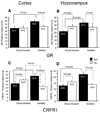Effects of stress and stress hormones on amyloid-beta protein and plaque deposition
- PMID: 19584430
- PMCID: PMC2905685
- DOI: 10.3233/JAD-2009-1152
Effects of stress and stress hormones on amyloid-beta protein and plaque deposition
Abstract
Growing evidence indicates that physical and psychosocial stressors, in part acting through the hypothalamic-pituitary-adrenal (HPA) axis, may accelerate the process of Alzheimer's disease (AD). In this review, we summarize recent research related to the effects of stress and stress hormones on the various disease process elements associated with AD. Specifically, we focus on the relationships among chronic stressors, HPA axis activity, amyloid-beta protein, and amyloid-beta plaque deposition in mouse models of AD. The potential mechanisms by which stress and stress-related components, especially corticotrophin-releasing factor and its receptors, influence the pathogenesis of AD are discussed.
Figures





References
-
- Arnold SE, Hyman BT, Flory J, Damasio AR, Van Hoesen GW. The topological and neuroanatomical distribution of neurofibrillary tangles and neuritic plaques in the cerebral cortex of patients with Alzheimer’s disease. Cerebral Cortex. 1991;1:103–116. - PubMed
-
- Katzman R. Alzheimer’s disease. N Engl J Med. 1986;314:964–973. - PubMed
-
- Storandt M, Grant EA, Miller JP, Morris JC. Rates of progression in mild cognitive impairment and early Alzheimer’s disease. Neurology. 2002;59:1034–1041. - PubMed
-
- Stozicka Z, Zilka N, Novak M. Risk and protective factors for sporadic Alzheimer’s disease. Acta Virol. 2007;51:205–222. - PubMed
-
- Bruandet A, Richard F, Bombois S, Maurage CA, Deramecourt V, Lebert F, Amouyel P, Pasquier F. Alzheimer’s disease with cerebrovascular disease and vascular dementia: clinical features and course compared with Alzheimer’s disease. J Neurol Neurosurg Psychiatry. 2009;80:133–139. - PubMed
Publication types
MeSH terms
Substances
Grants and funding
LinkOut - more resources
Full Text Sources
Medical

